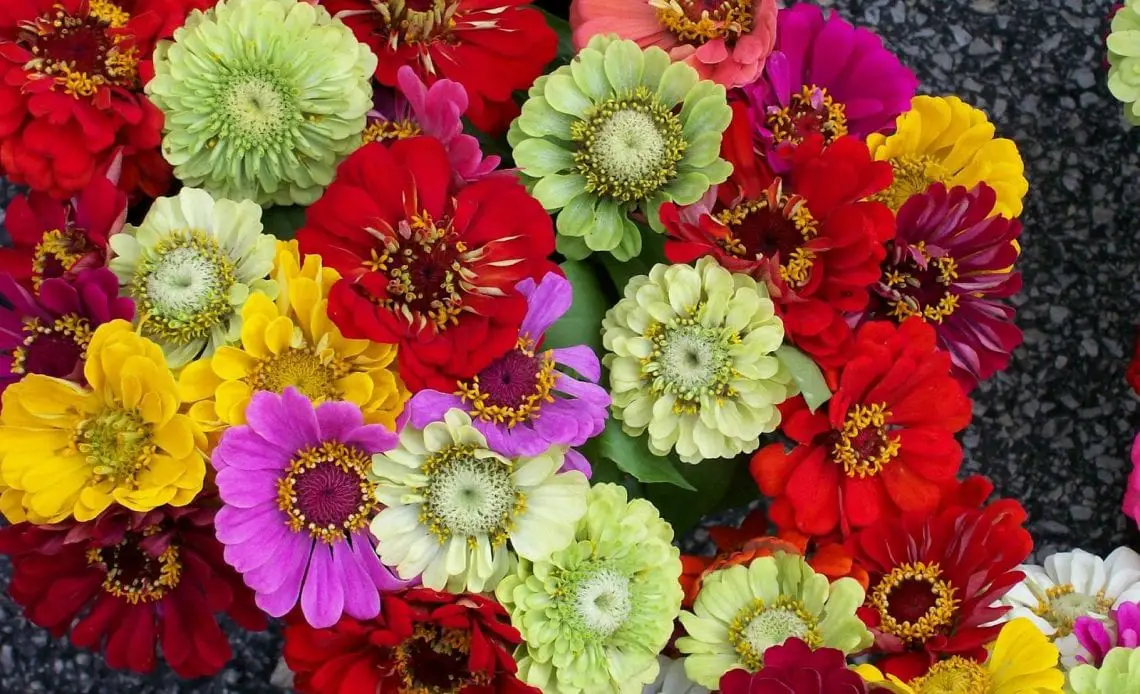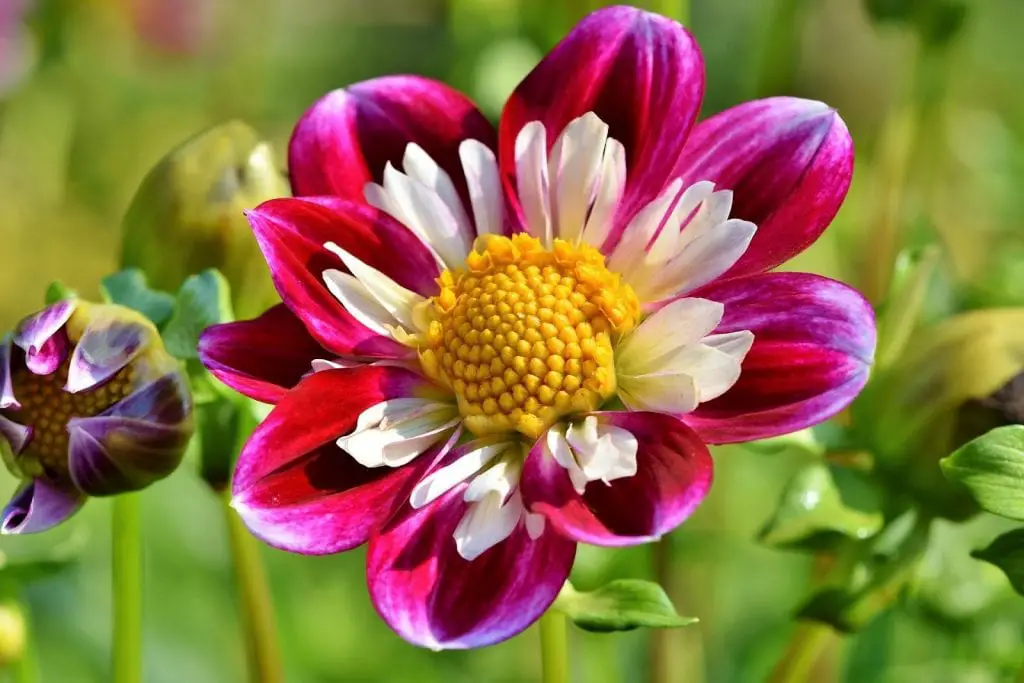
Zinnia flowers are often called rainbow zinnias due to their availability in every color of the rainbow spectrum. There are nearly 20 different species of zinnias and 100 cultivars. They come in various shades and hues of white, yellow, orange, red, purple, lilac/lavender and bright green. Some varieties are bi- or tricolor. Various cultivars blossom from spring to autumn. Zinnias bloom bountifully. Most zinnia varieties are exuberant and eye-catching.
Botanical Name: Zinnia L.(genus: Zinnia, family: Asteraceae)
Common Names: Crassina, Mendezia, Youth and Old Age, Diplothrix, Tragoceros
Etymology: Zinnias were named after Johann Gottfried Zinn, an 18th century German professor of medicine, botany and physics, who popularized zinnias in Europe. He discovered the flower in South America, brought it to Europe and started developing the first known zinnia hybrids.
Native habitat: Plants from the Zinnia genus are native to South America, Mexico and southern parts of the United States. They are typically seen in dry grasslands and scrublands.
The plant: Zinnias are annual summer herbaceous plants. They are easy to grow, tough and resilient. Zinnia is an erect plant with a single flower on each stem. Zinnias come as dwarf (15 cm tall and 30 cm wide), medium or tall (120 cm tall and 60 cm wide). The stems are hard, compact and sturdy. A single plant can produce many lateral, hairy branches.
The leaf: The leaves of zinnia are rough and often compared to sandpaper. They are narrow and lance-shaped.
The flower: Rainbow zinnias come as single, semi-double or double flowers. Depending on the variety and cultivar, the flower shape ranges from stars, buttons, beehive, daisies, domes, dahlias or quill-leaf cactus. The petals can be pointed, twisted or curved.
While some zinnias appear ordinary, other varieties can be distinctively unique. One such variety is Zinnia Elegans, whose large, vibrant flower includes at its center an inner ring of minute yellow flowers. Zinnia elegans comes in many colors (13 hues). Some cultivars from the Benary’s Giant series and the Berry Basket color scheme have flowers of raspberry, pink and grape color. Since the zinnia flowers are solitary, they are often used as a cutting flower. Rainbow zinnias make beautiful bouquets, and can be used in flower arrangements, both fresh and dry.
Scent: Zinnias do not have a distinctive scent.
Medicinal Use: Rainbow zinnias do not have any known medical purpose. Zinnias are sometimes used in soups, tomato dishes and pasta sauces.
Requirements: Rainbow zinnias are considered a low-maintenance garden plant. Zinnias grow best on organically-rich and well-drained soil (pH in the range of 5.5-7.5). They require regular and plenty of watering. Zinnias love the heat and do not tolerate frost. Although they like full sun (minimum for 6 hours a day), their flowering decreases during the peak of the heat in summer. Zinnias are not suitable for humid climates, as they develop powdery mildew. For longer flowering, dead flowers should be removed as soon as they appear. This process is known as ‘deadheading’. Zinnias attract butteries and birds (including hummingbirds and goldfinch).
Zinnia is a good companion plant since it helps defend against whitefly and other pests by attracting birds. However, zinnias can be susceptible to bacterial wilt, fungal spots, caterpillars and spider mites. To avoid the development of fungal disease, it is important to wet the soil and to leave the foliage dry. To prevent the spread of powdery mildew, add a tablespoon of baking soda to 4-5 liters of water, and spray it on the stems and the leaves of affected plants.
Planting instructions: Rainbow zinnias are best grown from seed. They can be planted as soon as the last winter frost is over, at the depth of 1-2 cm. Many gardeners prefer to plant mixed zinnia seeds — this creates a real burst of colors in the garden. To have zinnias flower for the longest possible period (early summer to late autumn), it is recommended to plant zinnias several times, leaving a gap of two to three weeks between consecutive sowing. The first sprouts appear within a week from sowing. It is difficult to transplant zinnias, and so direct-sow is the easiest method of planting. Adjacent zinnia plants should be kept approximately 40 cm apart. This provides them with sufficient air circulation and better resilience.
With exception to a few hybrid cultivars, the seeds of rainbow zinnias can be saved. Allow the flower petals to dry before you collect the seeds.
Rainbow zinnias are used in borders, containers or planted in huge masses. Dwarf varieties are suitable for window boxes, containers and edging. Short or medium ones are commonly used in borders. Taller varieties look good in the background of a flower bed. They are a perfect fit for patios and walkways, as they attract many birds and butterflies.

History of cultivation
Zinnias have been traced back to the ancient Mexican civilization. The Aztecs called them ‘plants that are hard on the eyes’ due to their vibrant blooms. Along different lines, the Spanish explores who arrived in Mexico in the 1520s disliked zinnias. They referred to them as ‘mal de ojos’ — sickness of the eye’ or ‘eyesore’. This was because Zinnia elegans and Zinnia peruviana, the two native zinnia species which they saw in the gardens of Montezuma were unimpressive. They have small, weed-like and pale flowers.
In the eighteenth century, European horticulturalists started cultivating zinnia flowers. In the late 1700s, Professor Casimir Gomez de Ortego sent zinnia seeds from Mexico to Spain. The seeds were sent to the wife of the British ambassador to Madrid. The flower became popular in the United States during the late 19th and early 20th century. Today, rainbow zinnias are among the most common ornamental flowers around the world.
Symbolism of rainbow zinnias
Most common symbolic meanings ascribed to zinnia flowers are: friendship, loyalty, thinking about and remembering lost or missing friends. These meanings belong to the Victorian tradition.
Different colors of rainbow zinnias have specific meaning. White stands for goodness, innocence and spirituality, pink and red for affection, scarlet for constancy, and yellow for joy. Mixed color zinnias represent memories beyond reach.
Zinnias are often gifted as a farewell flower, to express our affection and care for a friend who departs on a journey. Zinnias are also placed on the graves of loved ones, as they symbolize loving memories of those who are no longer with us.
Since rainbow zinnias bloom over a long period of time, they also symbolize endurance and strength, especially during difficult times.
Native American legend about zinnia flowers
Navaho and Apache Indians named the zinnia flower the ‘Ever-Changing Woman’. Since the plant keeps flowering, perpetually replacing old blooms with new ones, the Native American tribes regarded zinnias as personification of Mother Nature.
As the story goes, once upon a time a drought befell an Indian tribe, and they lost all their crops. They asked the Ever-Changing Woman for help, and she, in turn, directed them towards the Spider Woman. A young boy, the son of the Chief, went to meet the Spider Woman. She told him that the drought was a devilish act, and advised him to plant a particular, sulfur-colored zinnia flowers at night. The zinnia flowers sprouted by the power of the Ever-Changing Woman. For years after, these flowers continued to protect the tribe against hunger and misfortune.
Interesting facts about rainbow zinnias
- There are no blue, brown or black zinnia flowers yet. These are the only missing colors from the catalog of possible zinnia flowers.
- A common name of zinnias is ‘Youth and Old Age’. This name describes the fact that that old blooms and new blossoms can co-exist simultaneously.
- Zinnias were once named ‘poorhouse flower’ and ‘everybody’s flower’ because they were common, low maintenance and easy to grow.
- Zinnias are also known as ‘cut and come again’ flower. This name refers to the process of deadheading, commonly applied to stimulate abundant blossoming.
- Zinnia was an official state flower of the American state of Indiana from 1931 to 1957.
- The philosophical romance book ‘Marius the Epicurean’ by Walter Pater was published in 1885. The book features a scene in which two friends, Marius and Favian, visit a local flower-market, buy zinnias, and decorate with them the folds of their togas.
- ‘Zinnia Flower’ is the name of an artistically acclaimed, 2015 Taiwanese drama film.
- There is an opera called Zinnias: The Life of Clementine Hunter, composed by Robert Wilson in 2013. The opera was inspired by the art of Clementine Hunter, a 20th century prolific painter of zinnia flowers.
- Zinnia is the first flower humans grew in space. NASA has been testing samples of zinnia flowers in a space station (orbiting laboratory) since 2014. Scientists hope that studying zinnias can help them understand how microgravity impacts the growth and the flowering of plants. Zinnia was selected because of its sensitivity to light and other environmental parameters. Some early results showed that microgravity causes epinasty (flooding of the root). As a result, zinnia leaves bent and curled, but the plant finally bloomed in 2016.
